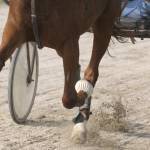Conformation Faults, Repeated Concussion May Lead to Ringbone in Horses

Any horse can develop ringbone, but it is most common in horses that have been used in ways that expose the hooves and pastern joints to high levels of concussion or strain.
Parade horses and those that pull carriages or carts on paved roads fall into this category. Disciplines that involve repeated landings on hard ground, such as jumping, or that incorporate sharp turns (barrel racing) may also lead to stress and torque that increase the risk of developing ringbone. Horses with particular conformation faults such as small feet, upright pasterns, and a toed-in stance are at a higher risk for ringbone.
Because ringbone is the result of arthritic changes that usually develop over many years of use, this problem shows up in middle-aged horses and is recognized because of lameness and a short, choppy stride. High ringbone affects the pastern joint and shows up as swelling around the pastern; low ringbone affects the coffin joint, causing swelling just above the coronary band at the top of the hoof.
Low ringbone has a poor prognosis for athletic use. High ringbone may be managed with anti-inflammatory medications or surgery to fuse the pastern joint.
Though ringbone can’t be cured, it can be managed with corrective shoeing, a period of rest, and anti-inflammatory injections into the affected joint. Generally horses with ringbone need to be put into less strenuous levels of work to avoid further joint damage and lameness.








